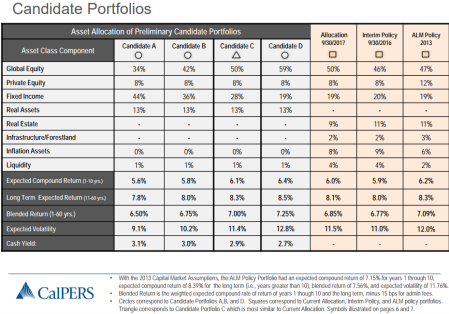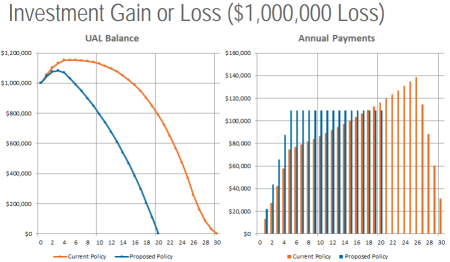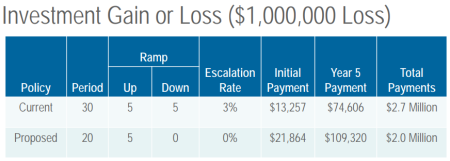CalPERS delayed action last week on the chief actuary’s proposal to shorten the period for paying off new pension debt from 30 years to 20 years, a cost-cutting reform that would end the current policy not recommended by professional groups.
The reluctance to impose a small short-term rate increase on struggling local governments may signal that the CalPERS board will not make a major shift of investments next month that would trigger the fifth employer rate increase since 2012.
Officials from two dozen cities and their associations told the board that rate increases are severely squeezing local government budgets. Most opposed the shorter debt payment period and two proposed investment reallocations that would raise rates.
“The common theme that you will hear is that the employer-pays-more option is simply no longer a viable option,” Dane Hutchings of the League of California Cities told the board last week. “The well is running dry.”
The cities urged the CalPERS board to choose an investment portfolio allocation next month that would leave the current earnings forecast at an annual average of 7 percent, avoiding a rate increase.
Two options with less risky but lower-yielding investments would cut expected earnings used to discount future pension obligations to 6.75 or 6.5 percent. To close the funding gap created by the forecast of lower earnings, employer rates would be raised.
The investment allocation decision next month follows a lengthy review done every four years. But last December the California Public Employees Retirement System broke the usual four-year cycle by dropping the earnings forecast from 7.5 to 7 percent.
The rate increase won’t be fully phased in until 2024. Some say the 7 percent forecast is too high. CalPERS experts predicted the portfolio would earn 6.2 percent next decade, before averaging more than 7 percent during the following two decades.
CalPERS also broke the four-year cycle by shifting to less risky but lower-yielding investments in September last year. By January, the rare attempt at market timing had cut earnings by $900 million as stocks began a post-election runup.
The unusual CalPERS moves last year — cutting investment earnings expected to pay 60 percent of future pensions while raising employer rates to get more money — resulted from the failure to recover from huge investment losses a decade ago.
Last year CalPERS had 68 percent of the projected assets needed to pay promised pensions, little changed from a low of 61 percent in 2009. Now after a lengthy bull market that tripled major stock indexes, some expect a correction or downturn.
Lacking the traditional cushion of 80 percent or more funding, CalPERS fears that another market crash like the financial crisis a decade ago could drop the funding level below 50 percent, a red line some experts say makes recovery very difficult.
So, instead of taking on more investment risk to increase earnings and the funding level, CalPERS went the other way, reducing risk and earnings to decrease the odds of funding dropping below the 50 percent red line.
Last week, some cities warned of their red line by repeating that the “employer-pays-more option is no longer viable”. With the exception of new hires since a reform in 2012, employee contributions are frozen, set by statute and protected by court decisions.
Scott Terando, the new CalPERS chief actuary appointed in January, told the board the current actuarial policy of delaying debt payment is one reason the funding level did not recover after the financial crisis.
CalPERS was 100 percent funded with investments valued at $260 billion in 2007, before plunging to 61 percent funded and investments worth about $160 billion in early 2009. The investments were valued at $343 billion last week.
Until a reform in 2013, CalPERS had spread the recognition of investment gains and losses over 15 years, far beyond the 3 to 5 years used by many pension plans. The lengthy “smoothing” period avoided jumps in employer rates, but also delayed debt payment.
CalPERS also had been using “rolling” or “open” amortization to pay off the debt or “unfunded liability” from investment returns below the annual earnings forecast, now 7 percent. The debt was refinanced annually and theoretically might never be paid off.
The reform in 2013 pays off debt from below-target investment earnings over 30 years. Employer rate increases are gradually increased during a five-year “ramp up” and remain at the full amount for 20 years, before a five-year “ramp down” ends the payment.
“So, what happened is we moved a notch from basically ‘unacceptable’ to ‘not recommended,’ and that’s where we are today,” Terando said, referring to guidelines from the California Actuarial Advisory Panel and several other professional groups.
Most California public pension systems are said to use the recommended 15 to 20-year payment periods. Among 17 systems listed in a staff report only the Los Angeles County Retirement Association had a 30-year payment period.
Under the current CalPERS 30-year payment policy, the debt continues to grow for the first nine years. The payment is not large enough to cover the interest, the amount that could have been earned if the debt were invested and yielded the earnings forecast.
Actuaries call that “negative amortization.” And under the current CalPERS 30-year policy, the payments do not begin reducing the original debt until year 18, more than halfway through the period.
“So, you make 18 years of worth of payments and you are right where you started from,” Terando said. “That’s kind of the reason our funding status has remained flat while our assets have grown.”
Current CalPERS policy uses a “level percentage” of payroll payment. For example, 3 percent of pay becomes more costly as payrolls grow over the years. Terando is proposing a “level dollar” payment that does not grow with the payroll. (see chart below)
The proposed 20-year payment period saves money. The total payment for a $1 million investment loss is $2 million, compared to $2.7 million under the 30 year plan. Less debt is pushed to future generations. The funding level recovers faster.
But employer rates are likely to increase, probably for the first two years, Terando told the board. CalPERS employer rate increases can face resistance from unions, who argue that taking money off the bargaining table should be negotiated.
Last week, board members cited city opposition to another rate increase as they suggested alternatives to Terando’s proposal: waiting until the 3-year phase in of the 7 percent discount rate is completed, only switching to level dollar payments, hardship exceptions, and a 25-year period.
Rob Feckner, board president, thanked Terando for his professionalism and standards. He said in a “perfect world” CalPERS should start paying off the debt from investment losses in the recommended 15 to 20-year period.
“Somehow we need to be able to find an area where we can give them (local governments) options, instead of us being the hammer because it’s not going to be a pretty picture,” Feckner said.
CalPERS encourages local governments to make extra payments to pay down debt faster. A city-backed request to analyze cost-cutting suspensions of COLAs and lower future pension earnings for current workers was rejected by the CalPERS board in September.
Richard Costigan, finance committee chairman, said there will be a workshop and a survey of employers before the committee considers Terando’s proposal again in February, a delay in action originally scheduled for next month.
Reporter Ed Mendel covered the Capitol in Sacramento for nearly three decades, most recently for the San Diego Union-Tribune. More stories are at Calpensions.com. Posted 20 Nov 17



November 20, 2017 at 10:54 am
Just wait until the next bear starts w a 30-40-60% decline. The Calpers investment folks are morons.
>
November 20, 2017 at 12:21 pm
“The common theme that you will hear is that the employer-pays-more option is simply no longer a viable option,” Dane Hutchings of the League of California Cities told the board last week. “The well is running dry.”
Well they could always eliminate public services. Other than “pension collection gangs” to go around evicting people who refuse to pay taxes with no services in return.
I don’t see how they could consider pension contributions optional, after feeling free to jack up pension benefits.
November 20, 2017 at 3:53 pm
If the promised benefits are SO COSTLY that you have to put in place unreasonable practices (i. e., 30 year amortization) to have sufficient revenue for other NECESSARY obligations, and when due to demographics (i. e., retiring baby boomers) the ranks of retirees will rise sharply over the next decade, what make ones think that deferring those costs to latter years won’t make the ability to pay for those promises not far MORE difficult?
Funding discussions are a waste of time.
Notwithstanding complicating Regulations, Laws, Constitutional Issues, Contract Clauses, and Case Law, ANY effective “solution” to the pension mess infecting many of Americas States & Cities MUST include (as just one necessary step) a VERY material (think 50+%) reduction in the value of future service pension (AND benefit) accruals for all CURRENT workers.
Who was that that said …………… the FIRST step in digging yourself out of a deep financial hole, is to STOP digging.
November 20, 2017 at 4:55 pm
The most important components to solve the CaLPERS pension tragedy is to extend the retirement age and to limit salary increases for pension purposes(freeze them until the mess disappears). Kern v. City of Long Beach made it clear that such a change can be made to protect a failed pension system. A mathematician colleague recently produced a formula that proved that market “volatility kills DB plans.”
November 20, 2017 at 5:23 pm
John Moore,
Insatiable greed and self-interested, vote-selling, contribution-soliciting Elected Officials kill DB pension Plans.
November 20, 2017 at 6:45 pm
The California Supreme Court needs to stop dragging its heels and uphold the First District Court of Appeals ruling that benefits not earned yet are not vested and allow all government agencies to save their pension systems by lowering benefits going forward to PEPRA levels for all current employees, not just the ones hired after 2013.
Until then John Moore is correct. Freeze all salaries until plans become at least 90% funded and raise retirement ages by enacting a penalty for early retirement.
November 20, 2017 at 8:05 pm
“Lacking the traditional cushion of 80 percent or more funding,”
I would think a “cushion” ought to mean more than is needed to fund existing obligations (that is for employment that is already in the past), that is over 100%, after “lengthy bull market that tripled major stock indexes,” correction would be expected. The notion that pension funds shouldn’t be greater than fully-funded at the peak of business cycles is a dangerous idea.
Its wrong in the first place to shift the cost of government employment on to future taxpayers. But having already done so, two decades of taxes collected going forward to pay it off is bad enough. That California would stretch it out so that those not yet born would be paying for a decade or more after they become taxpaying adults for government employment that ended before their birth is outrageous.
November 20, 2017 at 10:54 pm
“CalPERS employer rate increases can face resistance from unions, who argue that taking money off the bargaining table should be negotiated.”
If I’m correctly interpreting this wording, unions believe that local governments should negotiate with them over how much of a local government’s total general fund should be used to pay bills (e.g. unfunded pension obligations) versus being reserved for employee salaries/benefits. Now that’s chutzpah!
November 20, 2017 at 11:35 pm
George Brett,
What’s surprising to ME is that such behavior surprises YOU.
There is very little more greedy than a Public Sector Union/Worker.
November 21, 2017 at 3:38 am
It’s very simple folks. If your fund is 70 % funded, you get 70% of your payment as a retiree. This way, they see the way their plan is headed. Maybe then, their reps will come to the table and bargain as if their future depends on their sacrifice, not only the taxpayers.
November 21, 2017 at 6:30 pm
Move everyone to Social Security
Here’s my solution:
https://drive.google.com/file/d/0B90sU3A85q46OE9BZHJFSWEzbGM/view?usp=drivesdk
Thoughts?
November 22, 2017 at 2:13 am
Bob Woodward: It’s very simple folks. If your fund is 70 % funded, you get 70% of your payment as a retiree.
Nope. When I hired on as a civil servant, I was handed a brochure that said “if you work X years you will get Y% of your final pay as a pension.” I met my end of the contract, I worked my X years and paid in as required. Now it’s time for me to collect and I am entitled to 100% payment. A contract is a contract. Pay up.
November 22, 2017 at 2:57 pm
Not if your “civil service” agency goes BK – then you are treated as just another creditor – pennies on the dollar!
November 23, 2017 at 4:35 pm
T B Not if your “civil service” agency goes BK – then you are treated as just another creditor – pennies on the dollar!
Bob retires in 2005 from the City of Podunk. In 2018 Podunk elects some incompetent boobs who completely blow up the budget. Podunk goes BK, Bob gets his pension cut — through no fault of his own. Yeah, that’s fair.
November 23, 2017 at 6:19 pm
What’s “fair” is not in play here, it’s simply a math problem with no current solution. So something must be done. The public unions know the problem, they just thought that taxpayers would keep paying more and more for pensions that they themselves could never dream of having! We are finally waking up.